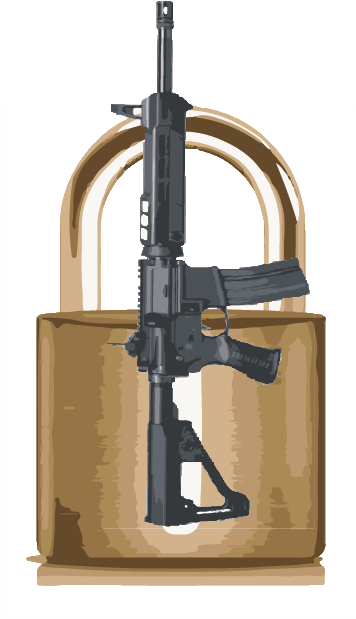Until they’re locked up, keep them locked out
Gun reform is necessary but legislative action is lagging, requiring us to rely on programs like LOCK to keep us safe
May 2, 2018
When news of the deaths of 17 students and faculty members at Marjory Stoneman Douglas High School filtered through every news outlet in the nation on Feb. 14, reactions were varied. The grief, confusion, anger, doubt and shock that ripped through each community—from the suburbs of south central Florida to the steps of the Capitol building in Washington D.C.—could not be denied. For many students, each of those feelings soon gave way to fear for their own safety. If it happened in Florida, why not Texas? If it happened in Parkland, why not Austin? If the students who write for The Eagle Eye, the Marjory Stoneman student newspaper, had to publish obituaries, why not us, the students who write for The Shield? Administrators picked up on these fears quickly and set to finding a solution.
“We’ve always been [evaluating the safety of our campus], but [the district] wanted us to look at it all over again and kind of reevaluate how we do things,” assistant principal Gabe Reyes said. “So, the initiative was to try to secure the building as best we could.”
The solution, as all members of the McCallum community have surely noticed, is the LOCK program. According to the program, all classroom doors must be locked during school hours, outside doors must remain locked unless designated to remain open, the main office must be contacted in case of emergency, and all students and faculty must know lock down, reverse evacuation and fire-drill procedures. Although action was initiated by district officials, the LOCK program is unique to McCallum.
“The LOCK program is basically ours,” Reyes said. “It’s what we’re doing here. Other schools have their own programs. So we kind of looked at it and said, ‘Well, let’s get our own little program that’s kind of unique to us,’ because of the way our building is set up.”
Assistant principal Andrew Baxa and principal Mike Garrison joined Reyes in taking on the task of evaluating and implementing this new, unique program, which they developed through a process of trial and error.
“It’s been kind of ongoing, and it’s kind of evolved [as we saw] what worked and what didn’t work,” Reyes said. “We didn’t want to put a whole program in and then go, ‘Oh, we’ve got to change this, change this…’ So we kind of tested it out [to] see how we could get kids back and forth. And we know that it creates some challenges for kids to get to class and back, [but] the kids understand. I think they fully understand why we’ve [implemented the program] and hopefully they understand that it’s still a work in progress.”
It’s a work in progress, but some students feel like the idea is altogether a bad one. I’ve heard quite a bit of grumbling as I’ve walked through the halls or stood outside locked doors, tapping on Plexiglas windows for someone to please, let us in. Some treat the LOCK program as Marjory Stoneman Douglas students have treated the new clear backpacks that have been issued to them: with contempt, as any ridiculous idea should be. But as annoying as a couple of locked doors can be, the program isn’t ridiculous. It’s necessary.
Gun violence is a complex issue that will take complex solutions. We need legislative reform that will keep those who could cause serious harm to be kept away from guns, and if necessary, away from society. It’s what we’ve been asking for in the explosive March For Our Lives movement, and it’s the reason so many of us stood up and walked out for the anniversary of the Columbine shooting just one week ago. I want reform, but in the meantime, I want security. Nothing happens overnight, especially when Congress is involved, so the initiatives like the LOCK program take action when others won’t. It’s not perfect, and it’s not convenient, but it’s a fair price to pay.
Those who complain about the toll that locked doors adds to their class commute also point out that when even one door is left unlocked, a shooter can still get in, contradicting their previously stated need for unlocked-everything. This is undoubtedly true, as anyone who really, truly wants to get into the building will find a way, but three entry points are much easier to monitor than 13 (which is the amount of entrances to the main building that remained unlocked before the program). We have accused those in charge of doing nothing, and yet we accuse them of doing too much and too little all at once when they put in the effort to devise an honest solution. Scaling back would put us in the same position as before while doubling down would lead to increased resistance (McCallum, a closed campus? Can you imagine?)
There’s a second solution, one that we can all participate in. The ‘C’ of the LOCK program touches on it: Call.
“If you see something, say something,” Reyes said. “Kids are the eyes and ears of what’s going on [around] campus. If you see something as a student, if you see an adult or somebody on campus that you don’t recognize, let an adult know that way we can deal with it as administration. We have our SROs that are also on campus, so anytime that happens when you see somebody or something that’s not right, just like the district says, if you see something, say something.”
It’s essential that we know what we can do to keep ourselves and our classmates and teachers safe, and that includes allowing administration to implement their own ideas of what is best for our collective safety.




